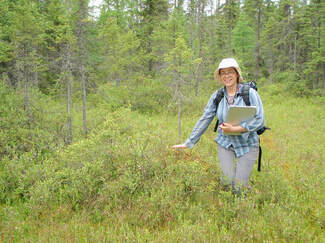What is the Ontario Wetland Evaluation System (OWES)?
Authored by Rebecca Rooney on November 7th, 2022
 The author at an Ontario Wetland Evaluation training session in 2013
The author at an Ontario Wetland Evaluation training session in 2013
When Ontario introduced the science-based Ontario Wetland Evaluation System in 1984, it was truly pioneering. Called “OWES”, it was one of the first tools to measure the functions and values of wetlands to inform their management in North America. Ontario has remained a leader in wetland evaluations, updating OWES as new science and technologies became available.
OWES is pretty sophisticated, but the concept is simple: it’s a report card that a certified evaluator completes to grade a wetland in four “subjects”: Biological, Social, Hydrological, and Special Features.
The local Ministry of Natural Resources and Forestry office reviews the OWES report card.
Provincially Significant Wetlands are supposed to be protected and the benefits they provide to society, the economy and the environment preserved for the long-term benefit of Ontarians.
OWES is pretty sophisticated, but the concept is simple: it’s a report card that a certified evaluator completes to grade a wetland in four “subjects”: Biological, Social, Hydrological, and Special Features.
- The Biological score reflects things like how big and productive the wetland is.
- The Social score covers economic values like wild rice or commercial bait fishing, as well as recreational values like hunting and bird watching. It can also count things like traditional Aboriginal uses and cultural heritage.
- The Hydrological score combines many ecosystem services.
- Things like replenishing aquifers, preventing floods and shoreline erosion, mitigating climate change and purifying water.
- Collectively, these ecosystem services have been valued by economists at billions of dollars each year in southern Ontario alone!
- The Special Features score captures how rare the wetland is – in some parts of Ontario 90% of wetlands have already been destroyed, so the remaining wetlands are considered precious.
- It also captures wetlands providing habitat for threatened or endangered species. Fully 1 in 5 of Ontario’s species at risk depend on wetlands for their survival. No wonder, given high historic rates of wetland destruction!
- Wetlands are key habitat for waterfowl and other birds as well as spawning and nursery habitat for many fish. This can also raise a wetland’s Special Features score.
The local Ministry of Natural Resources and Forestry office reviews the OWES report card.
- Any wetland that scores high enough gets designated as a Provincially Significant Wetland. The capital letters tell you this is a big deal.
- Municipalities are responsible for incorporating Provincially Significant Wetlands into their Official Plans and ensuring that they are not developed or altered in accordance with the Provincial Policy Statement.
Provincially Significant Wetlands are supposed to be protected and the benefits they provide to society, the economy and the environment preserved for the long-term benefit of Ontarians.
